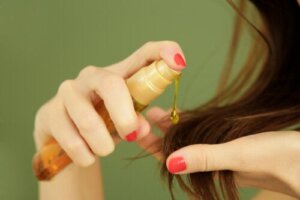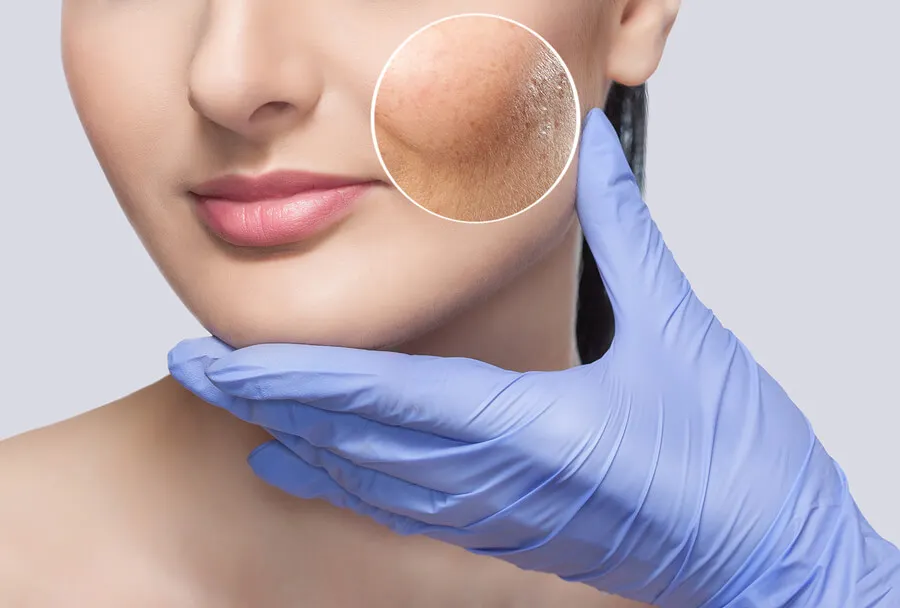Dimethicone for Hair: Uses, Possible Risks and Alternatives


Reviewed and approved by the nurse Leidy Mora Molina
Dimethicone is a silicone-based polymer that’s present in several personal care products and which has sparked controversy. While some think it should be part of the toxic products list in the beauty world, others believe it shouldn’t. Find out about the advantages and disadvantages of dimethicone for hair in this article!
This compound is found in skin and hair care products. Dimethicone helps form a protective barrier that decreases moisture loss in the skin and hair strands. Opinions are divided as to its safety.
Dimethicone: what is it?
Dimethicone is a polymer derived from silicone. The latter is derived from silica, a naturally occurring compound found in elements such as sand, sandstone, quartz, and granite.
When the sand is subjected to very high temperatures, dimethicone is obtained.
This compound is also known as polydimethylsiloxane. It’s one of the most widely used in the cosmetics industry and its most valued characteristic is its viscoelasticity, which makes it flexible and moldable.
It gives a soft and silky texture to skin and hair products, and a velvety appearance. It’s odorless, colorless, hypoallergenic, and non-comedogenic.
Anorher great article for you, slected for you, and all about How to Identify Quality Cosmetics
Uses and benefits
The main reason dimethicone is used in cosmetic products is the texture it provides. This compound gives such products a soft, smooth, and slippery feel on contact.
It also has some positive effects, such as the following:
- The formation of a temporary barrier. Dimethicone settles on the skin and hair forming a barrier that protects against irritants and allergens.
- Retains moisture. The barrier effect helps to retain moisture in skin and hair.
- Smoothes enlarged pores and fine lines. Dimethicone partially fills in cracks and gives the skin a more even texture.
- Coats the hair cuticle. This is similar to the effect it has on the skin. This leads to the hair shaft looking and feeling more uniform.
- Provides a matte finish. It seals in moisture without using grease. This is why it’s widely used in foundations and moisturizers for oily skin, as it provides a shine-free finish.

Possible risks of dimethicone for hair
Generally speaking, dimethicone is a safe compound. However, one report noted that the buildup of this substance can cause hair loss. The barrier effect would trap moisture, but also prevent additional moisture from penetrating.
This would lead to dry, brittle ends and dry, lifeless hair strands. Dimethicone isn’t water soluble. Therefore, it isn’t easily broken down by washing.
The U.S. Food and Drug Administration (FDA) approves the use of this compound as an active ingredient. Dimethicone rarely causes adverse effects on the skin, and, when it does, it’s only temporary. Such effects can be itching, redness, burning, or stinging.
These types of silicones aren’t absorbed by the skin and hair. So, when they’re washed out, they go straight down the drain and from there end up in rivers and oceans.
If they accumulate, they’re toxic to flora and fauna. A 2021 study warns about the negative effects of silicones on the environment.
You might also be interested in: 9 Natural Ways to Make Your Hair Shine
Identify products
Dimethicone is one of the components of countless cosmetic and medical products. It’s found in different proportions, ranging from 15% to 60%.
It’s important to look at the label of the articles, where this compound can be found under one of the following names:
- Amino Bispropyl Dimethicone.
- Aminopropyl Dimethicone.
- Amodimethicone.
- Behenoxy Dimethicone.
- C30-45 Alkyl Dimethicone.
- C24-28 Alkyl Dimethicone.
- Cetyl Dimethicone.
- Dimethicone.
- Dimethoxysilyl Ethylenediaminopropyl Dimethicone.
- Hydroxypropyldimethicone.
- Polydimethylsiloxane.
- PDMS.
- Stearamidopropyl Dimethicone.
- Stearoxy Dimethicone.
- Stearyl Dimethicone.
- Vinyl Dimethicone
Dimethicone is usually found in products such as the following:
- Sunscreens
- Sexual lubricants
- Moisturizing creams
- Anti-itch creams
- Lice removal products
- Shampoos and conditioners
- Makeup foundations and pre-bases
- Medications for flatulence or treatment of irritable bowel syndrome

Alternatives to dimethicone
Research conducted in 2018 indicated that vegetable oils have a more beneficial effect on hair compared to products made from silicones. They provide longer-lasting strength and shine. There are several products on the market that are marketed with the label “silicone-free”. Some alternatives to dimethicone products are those containing the following:
- Coco-Caprylate/Caprate.
- Benzyl ether myristate PPG-3.
- Dicaprylate/Butylene glycol Dicaprylate/Dicaprate.
- Isopropyl Myristate.
- C12-15 Alkyl Benzoate.
For skin-only products, alternatives to dimethicone are as follows:
- Hyaluronic acid
- Colloidal oatmeal
- Squalene
- Glycerin
- Kaolin
Dimethicone isn’t a dangerous product by itself. In fact, it’s very beneficial, but its action is superficial and temporary, and, when it accumulates, it can cause undesirable effects.
However, its negative effects on the environment are very concerning, and we advise that you look for alternative products when seeking to protect and preserve the natural environment.
All cited sources were thoroughly reviewed by our team to ensure their quality, reliability, currency, and validity. The bibliography of this article was considered reliable and of academic or scientific accuracy.
- Rushton H, Gummer C, L, Flasch H: 2-in-1 Shampoo Technology: State-of-the-Art Shampoo and Conditioner in One. Skin Pharmacol Physiol 1994; 7:78-83. doi: 10.1159/000211278.
- Kostik, A. (2021). Kostic A. Silicones in cosmetics and their impact on the environment. Cos ACTIVE J. 2021; 1:34–3934. Cos ACTIVE. Recuperado 28 de agosto de 2022, de https://cosmethicallyactive.com/wp-content/uploads/2022/01/Silicones-in-cosmetics-and-their-impact-on-the-environment.pdf.
- Leite, M. G. A., & Campos, P. M. B. G. M. (2018). Development and efficacy evaluation of hair care formulations containing vegetable oils and silicone. International Journal of Phytocosmetics and Natural Ingredients, 5(1), 9-9.
- Assencio-Ferreira, V. J. (2001). Manifestações neurológicas na intoxicação de lactentes pela associação dimeticona e homatropina: relato de 6 casos. Arquivos de Neuro-Psiquiatria, 59, 238-241.
This text is provided for informational purposes only and does not replace consultation with a professional. If in doubt, consult your specialist.








